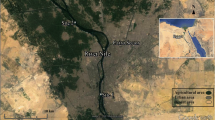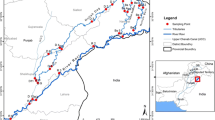Abstract
The presence of biphenyl was investigated in sediments and water in Paranagua Bay. Chemicals compounds like biphenyl can cause several effects on the ecosystems such as bioaccumulation. Biphenyl and similar compounds are subject to bioaccumulation, which in turn may harm the local ecosystem. The bioaccumulation in the local trophic chain was evaluated using a mathematical model based on toxicokinetic properties of the compound in the organisms. The results showed that even in water, the concentration of biphenyl was high, 0.82 ng/L. Also, in the fishes, the concentrations calculated by the model were higher than the maximum than the maximum allowed for human consumption.
Similar content being viewed by others
References
Arnot, J. A., & Gobas, F. A. P. C. (2004). A food web bioaccumulation model for organic chemicals in aquatic ecosystems. Environmental Toxicology and Chemistry, 23(9), 2343–2355. doi:10.1897/03-438.
Bruggeman, W. A., Opperhuizen, A., & Wijbenga, A. (1984). Bioaccumulation of super-lipophilic chemicals in fish. Toxicological and Environmental Chemistry, 7(2), 173–179. doi:10.1080/02772248409357024.
Burkhard, L. P. (2003). Factors influencing the design of BAF and BSAF field studies. Environmental Toxicology and Chemistry, 22(2), 351–360. doi:10.1897/1551-5028(2003)022<0351:FITDOB>2.0.CO;2.
Burreau, S., Zebuhr, Y., Broman, D., & Ishaq, R. (2006). Biomagnification of PBDEs and PCBs in food webs from the Baltic Sea and the northern Atlantic Ocean. The Science of the Total Environment, 366(2–3), 659–672. doi:10.1016/j.scitotenv.2006.02.005.
CEPPA—Canadian Environment Protection Agency (2007). www.ceaa-acee.gc.ca. Accessed 03 September 2007.
CONAMA (National Environment Council-Brazil) (2007). Resolution 357/05. www.mma.gov.br/port/conama/legiabre.cfm?codlegi=459. Accessed 20 August 2007.
FishBase (2007). FishBase.www.fishbase.org, Accessed 02 September 2007.
Froehner, S., & Martins, R. F. (2008). Assessment of fate and bioaccumulation of benzo(a)pyrene by computer modeling. Quimica Nova, 31(5), 1089–1093. doi:10.1590/S0100-40422008000500028.
Gobas, F. A. C. (1990). Bioaccumulation of some polychlorinated dibenzo-p-dioxins and octachlorodibenzofuran in the guppy (Poecilia reticulata). Chemosphere, 20(5), 495–512. doi:10.1016/0045-6535(90)90107-5.
Gobas, F. A. P. C. (1993). A model for predicting the bioaccumulation of hydrophobic organic chemicals in aquatic food-webs: Application to Lake Ontario. Ecological Modelling, 69, 1–17. doi:10.1016/0304-3800(93)90045-T.
Gutierrez, A. G., Garnacho, E., Bayona, J. M., & Albaiges, J. (2007). Screening ecological risk assessment of persistent organic pollutants in Mediterranean sea sediments. Environment International, 33(7), 867–876. doi:10.1016/j.envint.2007.04.002.
Lana, P. C., Marone, E., Lopes, R. M., & Machado, E. C. (2000). The subtropical estuarine complex of Paranagua Bay, Brazil. In U. Seeliger & B. Kjerfve (Eds.), Ecological studies, coastal marine ecosystems of Latin America, (Vol. 144, pp. 131–139). Berlin: Springer.
Long, E. R., MacDonald, D. D., Smith, S. L., & Calder, F. D. (1995). Incidence of adverse biological effects within ranges of chemical concentrations in marine and estuarine sediments. Environmental Management, 19(1), 81–97. doi:10.1007/BF02472006.
Machado, E. C., & Sá, F. A. (2007). Qualidade dos sedimentos na área de influência das atividades do Porto de Paranaguá, PR.: Elementos Traço e Contaminantes Orgânicos. www.abequa2005.geologia.ufrj.br/nukleo/pdfs/0308_eunice_machado.pdf Accessed 18 August 2007.
Mackay, D. (1982). Correlation of bioconcentration factors. Environmental Science & Technology, 16(8), 274–278. doi:10.1021/es00099a008.
Mackay, D., & Gobas, F. A. P. C. (1987). Dynamics of hydrophobic organic chemical bioconcentration in fish. Environmental Toxicology and Chemistry, 6(4), 495–504.
Marcomini, A., Jonkers, N., Gomiero, A., & Pojana, G. (2007). Natural and synthetic endocrine disrupting compounds (EDCs) in water, sediment and biota of a coastal lagoon. Environment International, 33(7), 929–936. doi:10.1016/j.envint.2007.05.003.
National Library of Medicine (2007). Biphenyl. www.nlm.nih.gov. Accessed 17 August 2007.
Penteado, J. C. P., & Vaz, J. M. (2001). The legacy of the polychlorinated biphenyls (PCBs). Quimica Nova, 24(3), 390–398. doi:10.1590/S0100-40422001000300016.
Rezende, M. O. O., & Del Grande, M. (2003). Distribution of organoclorine compounds in water and sediments from Piracicaba River Basin/SP-Brazil. Quimica Nova, 26(5), 678–683.
Ribeiro, M. L., Laurencetti, C., Pereira, S. Y., & Marchi, M. R. R. (2007). Groundwater contamination by pesticides: Preliminary evaluation. Quimica Nova, 30(3), 688–694. doi:10.1590/S0100-40422007000300031.
Rissato, S. R., Libânio, M., Giafferis, G. P., & Gerenutti, M. (2004). Determination of organochlorinated pesticides in the water supply system, drinking water and soil of the region of Bauru (SP). Quimica Nova, 27(5), 739–743. doi:10.1590/S0100-40422004000500012.
Thomann, R. V. (1989). Bioaccumulation model of organic chemical distribution in aquatic food chains. Environmental Science & Technology, 23(6), 699–707. doi:10.1021/es00064a008.
World Health Organization (WHO) (2007). International Programme on Chemical Safety. www.who.int. Accessed 10 August 2007.
Zuin, V. G., Airoldi, F. P. S., Nascimento, N. R., Landgraf, M. D., & Rezende, M. O. O. (1999). Determination of pentachlorophenol and hexachlorobenzene in natural waters affected by industrial chemical residues. Journal of the Brazilian Chemical Society, 10(1), 25–30. doi:10.1590/S0103-50531999000100005.
Author information
Authors and Affiliations
Corresponding author
Rights and permissions
About this article
Cite this article
Froehner, S., Maceno, M. Assessment of bioaccumulation of biphenyls in the trophic chain of a coastal area of Parana, Brazil. Environ Monit Assess 164, 189–198 (2010). https://doi.org/10.1007/s10661-009-0884-y
Received:
Accepted:
Published:
Issue Date:
DOI: https://doi.org/10.1007/s10661-009-0884-y




